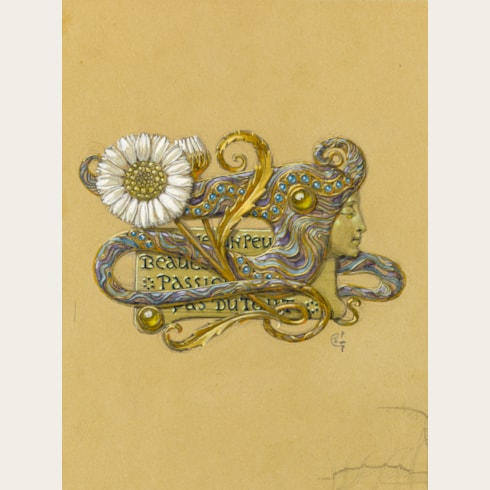Eugène GRASSET
(Lausanne 1845 - Paris 1917)
Design for a Comb in the Form of a Hydrangea Flower
Sold
Gouache, watercolour and gold over a pencil underdrawing, on light brown paper.
Numbered 1 on the verso.
217 x 147 mm. (8 1/2 x 5 3/4 in.) [image]
313 x 239 mm. (12 1/4 x 9 3/8 in.) [sheet]
Numbered 1 on the verso.
217 x 147 mm. (8 1/2 x 5 3/4 in.) [image]
313 x 239 mm. (12 1/4 x 9 3/8 in.) [sheet]
This drawing (which includes a sketch of the comb in profile, drawn in pencil near the right edge of the paper) is a design for a ‘Hortensia’ comb made by the jeweller Henri Vever around 1900. The piece was exhibited at the Exposition Universelle in Paris that year but is now lost, and its appearance is known only through this drawing for it.
A stylistically similar drawing by Grasset for a different comb, in the form of a sea nymph, is in the collection of the Cooper-Hewitt National Design Museum in New York. The comb itself, along with two other combs designed by Grasset for Vever, is today in the Musée des Beaux-Arts de la Ville de Paris at the Petit Palais in Paris; all three combs were presented to the museum by Henri Vever in 1925.
A similar depiction of hydrangeas is found in an earthenware and cloisonné enamel tile designed by Grasset for the ceramic factory of Emile Muller & Co. in Ivry in 1894.
A stylistically similar drawing by Grasset for a different comb, in the form of a sea nymph, is in the collection of the Cooper-Hewitt National Design Museum in New York. The comb itself, along with two other combs designed by Grasset for Vever, is today in the Musée des Beaux-Arts de la Ville de Paris at the Petit Palais in Paris; all three combs were presented to the museum by Henri Vever in 1925.
A similar depiction of hydrangeas is found in an earthenware and cloisonné enamel tile designed by Grasset for the ceramic factory of Emile Muller & Co. in Ivry in 1894.
One of the precursors of the Art Nouveau style, Eugène Samuel Grasset was trained as an architect in his native Switzerland and travelled to Egypt before eventually settling in Paris in 1871. He was mainly active as a specialist designer in the applied and decorative arts, in particular producing designs for jewellery, furniture and stained glass. He made a close study of Gothic architecture and stained glass windows, and became friendly with Eugène Viollet-le Duc, the architect responsible for the restoration of Notre-Dame. These archeological studies allowed him to create accurate depictions of medieval towns, castles, weapons and objects for the elaborate and beautiful illustrations that he produced between 1881 and 1883 for a lavish edition of the Carolingian epic Histoire des Quatre Fils Aymon. Published in 1883, the book is today recognized as an important forerunner of Art Nouveau book design in France. Grasset exhibited watercolours at the Société Nationale des Beaux-Arts and also showed a painting at the inaugural Salon de la Rose + Croix in 1892, a year after he took French nationality. He also exhibited at Le Libre Esthétique in Brussels and with the Vienna Secession.
It was not until 1894, when he was already in his early fifties, that Grasset had his first and only one-man exhibition in his lifetime; a large retrospective of his work at the Salon des Cent, a new gallery on the premises of the magazine La Plume. The exhibition included drawings and watercolours, numerous designs for furniture, stained glass, metalwork, fabric and jewellery, as well as theatrical and advertising posters, book and magazine covers, illustrations and other work as a graphic designer. Inspired by Japanese art (which he had noted at the Exposition Universelle of 1878) as well as medieval art, Grasset published two important books on ornamental design; La plante et ses applications ornamentales, which appeared in 1898-1899, and Méthode de composition ornamental, published in 1905. He also contributed articles and reviews to the journals Revue des Arts Décoratifs and Art et Décoration, and between 1881 and his death in 1917 served as the highly influential Professor of Decorative Arts at the Ecole Normale d’Enseignement du Dessin. Large groups of drawings, designs, studies and sketches by Grasset are today in the collections of the Musée d’Orsay and the Musée des Arts Décoratifs in Paris.
Provenance
Anonymous sale, London, Sotheby’s, 20 March 1987, lot 231
Ralph Esmerian, New York.






